Weapons on a 3D printer

3D short-range missile parts
Weapon XXI century. There are never too many weapons. Surplus, if someone decides that it is surplus, can always be sold, donated, and even simply disposed of at a profit. Well, in a war it is simply a sin to save ammunition - the more we throw explosives at the enemy, the ... faster we will realize the goals of military operations. But here's the problem... By tradition, weapons and ammunition are made from the best materials, steel and other metals, and this is expensive and not environmentally friendly.
It takes four tons of fresh water to smelt one ton of metal. Which after that will be undrinkable. And why would we then need thousands of steel shells if we do not have enough ordinary drinking water? In addition, the same shell bodies are also processed on lathes. And this is a shaving that needs to be collected and melted again. That is, the production of the past is very irrational from a technological point of view: a lot of water, a lot of waste, a lot of man-hours that need to be paid.
In the XNUMXst century, weapons and ammunition need to be produced differently.
"Printed Weapon"
In particular, today 3D printing technologies can be used for this. An example that has become a textbook refers to an event 10 years ago. Then in 2013, American student Cody Wilson 3D printed the very first plastic pistol that could fire live ammunition.
Further more - in 2017, a hand-held grenade launcher and more ammunition for it were printed on a 3D printer at the US Army Weapons Research Center. Moreover, it was emphasized that all the details were made in 3D technology. The well-known M40 A203 hand-held 1-mm grenade launcher and the M781 training grenade were taken as the basis for the design, since it was forbidden to make combat ones for it.
Printed grenade launcher...
To "print" a grenade launcher and grenades for it, several types of three-dimensional printing were used at once. The first is direct metal laser sintering, when the laser fuses the original metal powder into one part in layers, 3D printing from plastic and casting plastic parts in molds.
The greatest difficulty was the printing of the grenade launcher barrel, along with rifling, which was made of aluminum. The receiver was also made of aluminum. The trigger, drummer and trigger of the grenade launcher were also “printed”, but only from a steel alloy of the 4340 brand. The pistol grip butt, of course, was also made of plastic - the simplest parts for this technology in this case.
As a result, it turned out that in the grenade launcher only springs, mounting pins and screws were made in the traditional way, and everything else was made in the technology of the XNUMXst century.
True, both the barrel and the receiver had to be further processed and removed from the surface of roughness, and anodized for even greater rigidity.
In general, the manufacture of the grenade launcher required 70 hours for the actual printing and five hours for anodizing and fine machining. In general, this does not mean anything - it is a lot or a little. But they say prices that can be compared.

203D printed M1 A3 grenade launcher
So, the cost of a printed grenade launcher turned out to be a little more than a hundred dollars, and the lion's share of the cost fell on metal powders for layer-by-layer sintering. But the M203 A1 grenade launcher, made using standard technology, costs 1,1 thousand dollars. That is, 3D printing has even surpassed traditional production in terms of its cost effectiveness.
"Best the enemy of the good"
True, there are spots on the sun. Standard grenade cases are cast from zinc. But it was not possible to print them from zinc due to its specific properties. Printed from steel. But the steel grenade ripped off the aluminum barrel. They covered it with plastic. The plastic began to peel off! Then the grenade was made of aluminum, and it turned out to be lighter than zinc, and its firing range increased, which immediately made it impossible to use the old sight. The problem, of course, is “just grandiose”.
Well, according to the technology of three-dimensional printing, such details as a sleeve, a primer and ... a propelling powder charge were not made. It's just that in the US there is a ban on the use of explosives in products made using 3D technology.
But until recently, 3D printers could only be found in some research institutes. They helped create product prototypes, but nothing more. However, some 10-15 years have passed and additive manufacturing methods have been actively used both in the automotive industry and in aviation, and in the aerospace industry, as well as in medicine and instrumentation. And its benefits are obvious: this is a more economical consumption of raw materials and, most importantly, the possibility of producing geometrically very complex products.
In addition, the materials from which the printed parts are made are also beneficial. For example, ABS plastic is a modern synthetic thermoplastic that is widely used today among other structural materials. It has high strength and wear resistance, durability in operation, although it “does not like” ultraviolet radiation. It can be used at temperatures up to +80 °C, while maintaining all its technical properties. It is important that it is non-toxic and can withstand temperatures up to 100 °C for a short time. And ABS plastic is excellent for machining.
Other printing plastics or filaments are also known, in addition to ABC: PLA, PETG, Flex. Each has its own specific characteristics, so you can always choose the right one. That is, 3D printing opens up truly limitless possibilities for creating functional and highly efficient structures, including those in the military sphere.
And what about the price? For example, PETG plastic costs 10 rubles per gram, which, in principle, is relatively inexpensive.
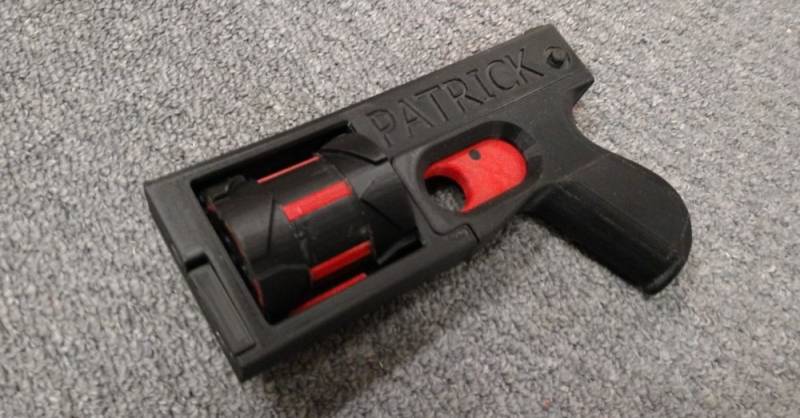
3D printed Washbear revolver
"After a single-shot pistol, an eight-shot revolver!"
By the way, as noted above, progress in “printed weapons” does not stand still, and the original six- or eight-shot revolver with an interchangeable drum chambered for .22LR cartridges has already been printed there in the USA. Its name is strange: Washbear, because it doesn't look like it, but it works!
The printing of an eight-shot revolver was made of ABS plastic, reinforced inside the drum with metal inserts. But a six-shot can be printed at all from a special nylon Bridge Nylon.
And what about us?
And we have the F2 innovations company, founded by graduates of the Perm National Research Polytechnic University (PNRPU), offers the F3 Gigantry granule 2D printer, capable of printing the largest products.
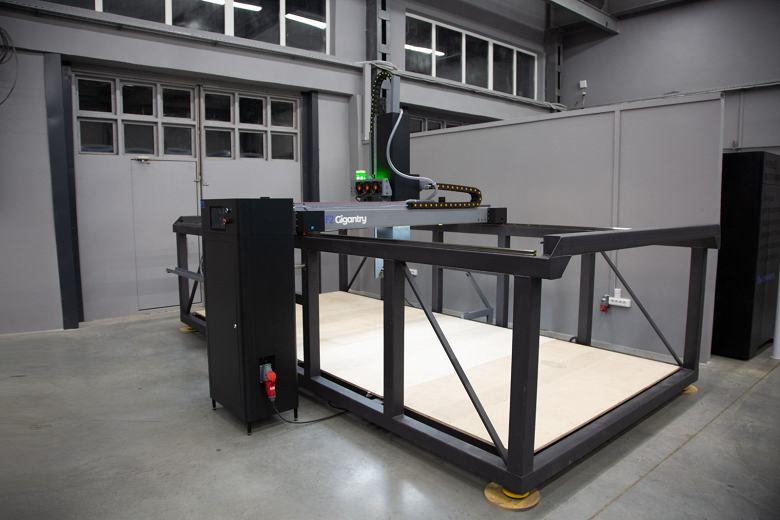
This is what F2 Gigantry looks like
The F2 Gigantry is a conventional 3D machine in which polymer granules are melted and fed to a printer that performs trajectory motion and layer-by-layer printing. But she is only capable of creating parts up to 4 meters long, 2 meters wide and 1 meter high. At the same time, it prints with a productivity of up to 10 kg / h, and it can also work on recycled materials, that is, on recycled granulate.
In general, the technology of such printing is not at all new, only such large Russian installations as F2 Gigantry have not yet been on our market.
The benefits of F2 Gigantry allow factories, and in particular the aerospace industry, to produce large-sized polymer parts very quickly and cheaply. The total costs are thus reduced by about 40 times compared to traditional technologies.
Interestingly, the first production printer, the F2 Gigantry model, was designed ... for a personal order to print tooling for the manufacture of composite wings for aircraft. But F2 Gigantry can be used in any field, including the field of military production.
"Rockets on the Line"
Now let's look at the photos. On them, a model of the V-2 rocket, assembled from parts printed on a 3D printer. There are 5 parts in total. This means that you need 5 printers and five workers who would process the finished parts at the time when the machine prints the next ones. At the same time, he is also engaged in their assembly. The one who is responsible for the "nose" inserts a fuse into it. Those who "have nothing much to do" when the part is processed, participates in filling the finished rocket with explosives. The person in charge of the tail section inserts a powder engine wrapped in asbestos into it.
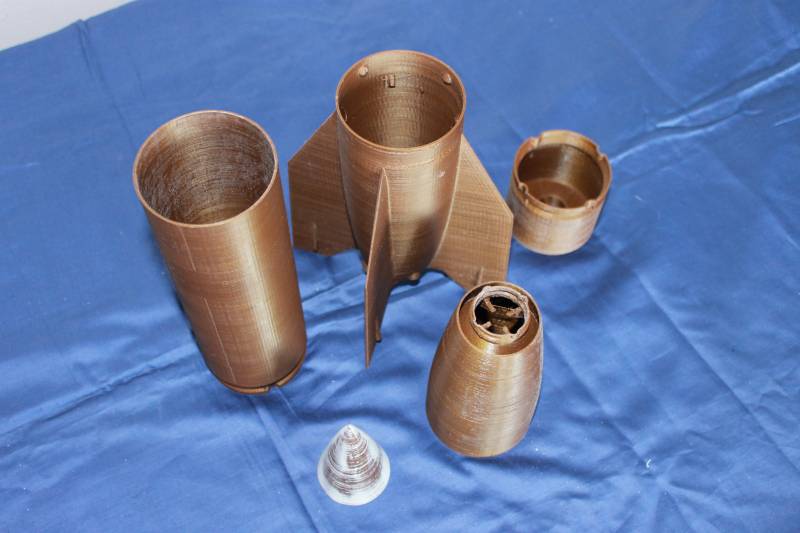
5 short-range rocket parts
Then, again, one of these 5 workers inserts the finished rocket into a cassette, also printed on a 3D printer, only in a large size, or made and assembled from a metal profiled sheet. The electrical wiring of the electric fuses is connected, and the “product X” is sent to the front. It is easily transported, easily camouflaged, and its range allows it to cover a large area with fire.
Such production works continuously, day and night, only shifts change. Moreover, it can be located in a concrete bunker not very far from the front line. The main thing here is good camouflage of access roads.
And after use, the cassette is disassembled and sent back or used to equip trenches!
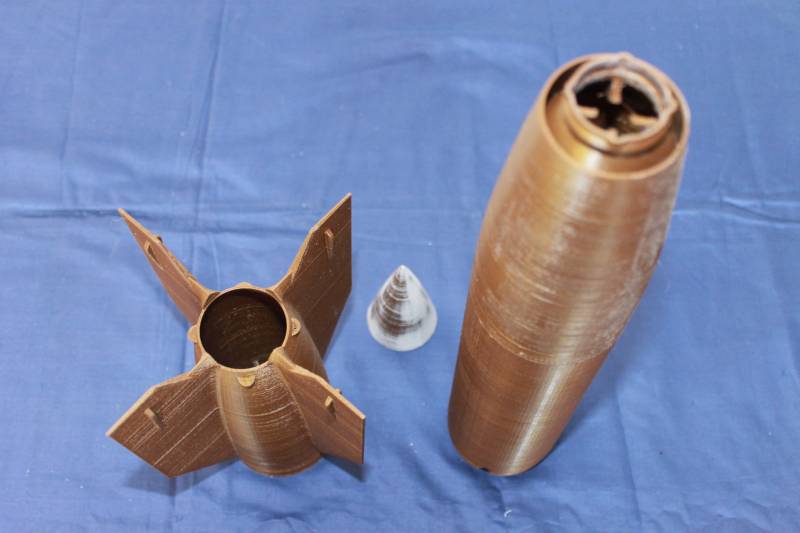
Three last details
Similarly, you can print and Drones. Large printer only. We print "bottom", we print "top", and with a minimum consumption of the cheapest plastic - after all, the flight is one way. The control unit is modular, the power battery is also a module with quick disconnect terminals, the fuel tank is ready, the charge is ready in the form of a “melon” with ready-made fragments, cumulative-fragmentation action, the camera is also a separate unit, which is screwed into place with four screws. Both halves of the body are glued together with superglue. That is, the assembly is similar to the Meccano children's designer.
In order not to be mistaken, the assembler can mark all the details with clearly visible numbers, and also their seats with numbers: 1 + 1, 7 + 7, yes, by the way, the seats themselves are only suitable for these parts, so item 8 in slot 9 do not insert.
The engine is our model MK-12V or analogues of the Super Tiger and Bangei 600 engines, with which such an “aircraft” could reach speeds of up to 225 km / h. This UAV starts with the help of a launch accelerator, which is reset after takeoff.
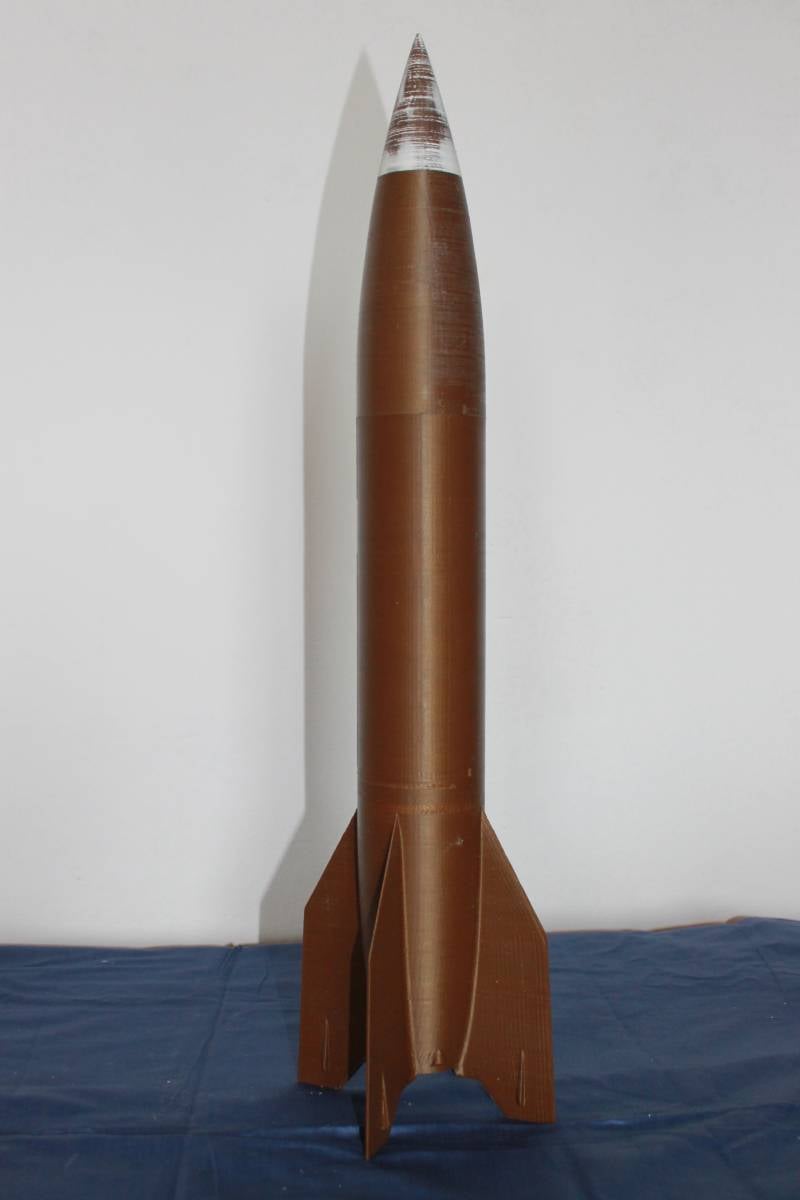
"Product X" is completely ready for launch
It is interesting that such "factories" can be installed on ships with great profit. After all, ready-made UAVs take up a lot of space during storage, but here they can be stored as they are produced and launched, which will save both space and time to carry out an attack with their help.
This is how the war of the XNUMXst century should be (and will be!). And the sooner the “decision makers” realize this, the better.
Information